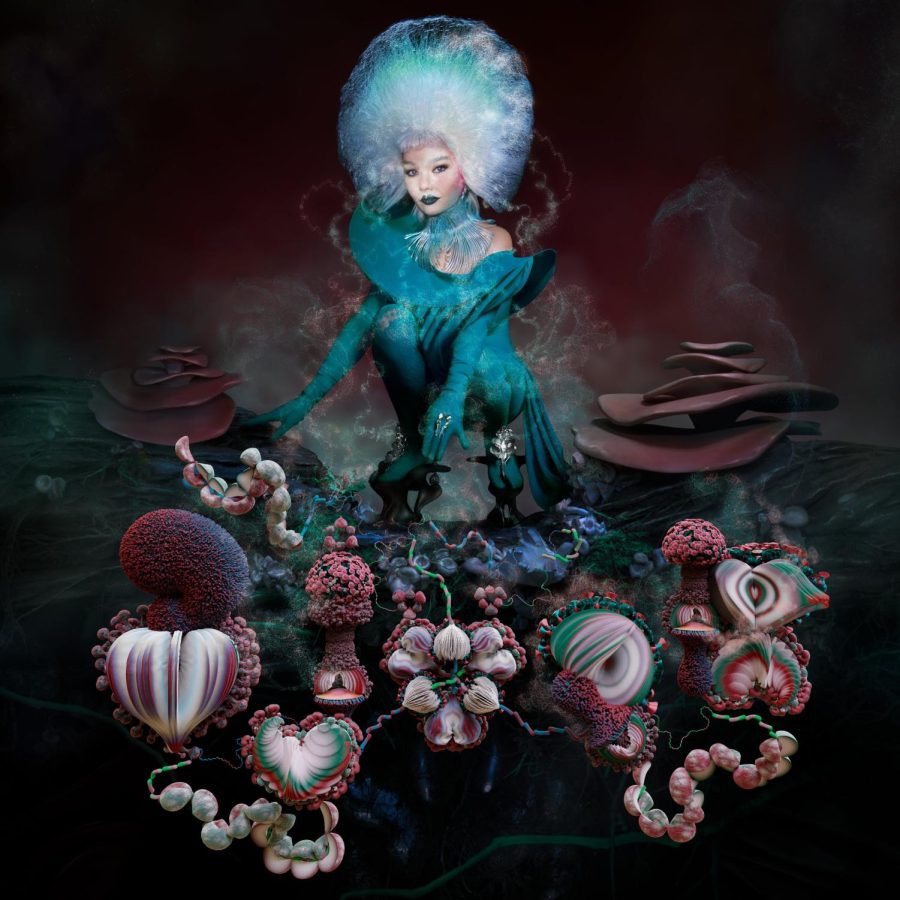“Fossora”: Björk digs into new sounds but stays rooted
Björk’s latest album “Fossora,” out last Friday, September 30 through One Little Independent Records, cycles through a vast array of sounds and themes while staying true to its central themes of hope, love and mushrooms.
For her latest project, Icelandic art-pop icon Björk dug deep — quite literally.
The title of her tenth studio album, “Fossora,” is a feminized version of the Latin term for “miner” or “digger.” It’s Björk’s self-described “mushroom album,” inspired by the feeling of “landing on the earth and digging my feet into the ground.” These themes of nature and groundedness inspire “Fossora,” an avant-garde, sometimes subtle, sometimes massive journey that explores motifs of death, love and hope. The album features a multitude of disparate themes and influences and just barely manages to fuse them together, creating a sometimes-confused but enjoyable work that pushes the limits of pop music, electronic music and everything in between.
Björk’s fascination with the natural lifecycle — life, death and rootedness — is apparent throughout the album, reflected through experimentation with folk tradition. For example, “Allow” gains its subtle strength from delicate, swelling natural instrumentation and multiple layers of airy vocals, and single “Ancestress” follows a similar sound with a slow, cinematic build through soft chimes, Disney-esque strings and concise storytelling.
However, besides the gorgeous, nature-inspired instrumentation of “Fossora,” there’s another side of the album, one that’s more edgy, hard-hitting, and synthetic. Lead single and intro track “Atopos” is an industrial banger, featuring a bass clarinet sextet blaring its way through quasi-atonal motifs in tandem with a distorted Reggaetón-inspired beat and lyrics about hope and human connection. If that sounds ridiculous to the degree of self-parody, well, I promise it’s better than I made it sound. Final single and penultimate title track, “Fossora,” also emulates this formula, with the same set of clarinets and distorted kick drums playing inquisitively in the background until the song evolves into a chaotic, dissonant drop inspired by the fast-paced and distorted techno subgenre of gabber.
While similarly rapidly-pulsating beats can be seen across a few tracks, they’re not nearly as present on the rest of the album. The same goes for many sonic ideas, including the bass clarinets, which appear on some tracks but which are conspicuously absent from others.
“I started this album very conceptual, like: This is the clarinet album,” Björk stated in an interview with Pitchfork. “Then halfway through, I was like, F*ck that.”
This non-committal sound palette nearly splits the album in two. Some of the album is marked by driving electronic music, while the rest is defined by lush, slow-building, almost-ritualistic performances. Luckily, the album is structured well enough that the dichotomy isn’t too jarring: most of the more subtle tracks reside near the middle of the album, while the hard bangers generally bookend the album.
These two groups aren’t mutually exclusive, either. Aspects of the two sides often blend together, coalescing into a harsher diversification of the album’s main sounds of Icelandic folk, layered choruses and chamber music. For example, the downtempo piece “Victimhood” pairs the ambiance and meditativeness of the album’s more organic tracks with the pulsating drums and dark clarinets of its more electronics-focused pieces.
Björk’s lyrics on the album also represent a diverse but central message: one of allowing space for reflection but of moving on with hope.
One central theme of the album — even if only a couple of songs are fully dedicated to it — is the 2018 death of Björk’s mother. In the acapella piece “Sorrowful Soil,” Björk shares an oblique, funereal reflection on motherhood (“In a woman’s lifetime / She gets four hundred eggs / But only two or three nests / Woven with a mother’s life force”). The aforementioned “Ancestress” is one of the album’s emotional climaxes, pairing vaguely-glitchy drums with Björk’s description of her mother’s life and passing. The song’s lyrics, which were condensed from several pages into their current, succinct form, feel less mournful than “Sorrowful Soil”: it celebrates her mother’s legacy, eccentricities and hope rather than focusing on her death alone.
This kind of tempered hope is a recurring theme. The album refuses to dwell in its depressive moments — as Björk herself stated, this is not a grief album, like 2015’s “Vulnicura”. Nor is it an album of ethereal euphoria, like her previous release “Utopia.” Instead, the project has its feet planted strongly on Earth, with realist optimism and a willingness to move on from the past. This is, perhaps, best represented by the title track “Fossora,” in which Björk utilizes fungi as a metaphor to describe her growth and ability to move on from past difficulties (“Her fossorial claw / Digs downwards / Dissolves old pain, dug down to rot / Decomposes debris”). Even the album’s love songs, like “Fungal City” — a song about a life-affirming, revitalizing relationship (“His vitality repolarizes me / My north-south shifts to east-west”) — are rooted in newfound transformation and growth, existing in the same arc of recovery as the rest of the album.
In writing and in sound, “Fossora” features numerous ideas that could’ve spawned entire albums on their own. From gabber to Icelandic folk and from failed relationships to personal loss, the album covers a wide breadth of styles and topics but ultimately finds a way to amalgamate them under a message of rehabilitation and a combination of sounds that, somehow, works. “Fossora” is not an immediate album: its slow-burning motifs and idiosyncratic ideas take multiple listens to truly unfold, but, for the patient listener, a rich world unveils itself. A rich world of orchestras, club bangers, clarinets, mushrooms and love.




